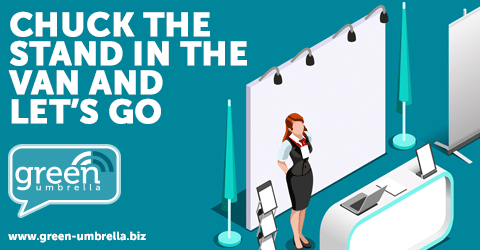Chuck The Stand In The Van And Let’s Go – The Trade Show!

Chuck The Stand In The Van And Let’s Go – The Trade Show!

With the biggest trade show in an industry close to my heart running as I write, it’s a marketing tactic that can drain the most generous of budgets very quickly. So how do you choose, plan and budget for these events? It’s just a little more complicated than the heading of this blog suggests.
Which ones?
Sounds obvious but the first step is to choose WHICH shows to attend. A ‘trade show’ can be anything from a few tables set up in a conference room to an all singing, all dancing, multi-hall, multi-day event.
Research all types of shows in the markets you are interested in and look at the statistics of previous year’s visitors. Most will either have this on their website or the organisers will be able to give you a breakdown. This is important for making sure that the visitor profile matches your target audience.
Timing
Then you need to consider timing issues – if two events run concurrently or very quickly after one another, do you have the resource to manage them both? If you want to launch a new product at the show, will it be ready in time?
Overlaid with any past experience you might have had (you DID measure results last year, didn’t you?) you can arrive at a shortlist.
Budgeting
Next, you need to think about budgeting. It’s not just the space and the stand you need to think about. Main areas of cost for a large show include:-
- Space
- Stand facilities e.g., electricity, internet, music licence
- Stand production and build
- Graphics design and production
- Hotel overnight costs
- Travel costs
- Uniforms for staff
- Giveaways
- On stand hospitality
- Off-stand hospitality, e.g., customer dinner
- Preshow communications, design and implementation
- Post show follow up
- Lead management system
- Cost of staffing
- Photography, video costs
- Social media costs
- Product and shipping costs
It’s useful to look at all your planned events together as you might be able to spread costs over multiple shows, if you can reuse graphics, uniforms, etc. and buy enough giveaways for all of them, thus getting the best unit price.
I always add up ALL the costs and divide by the number of minutes the show runs for. That way you get a cost per minute to exhibit – more on that later.
At this point, you might be crossing some events off your list!
Book the space
So, let’s assume you have your short list of shows. Obviously, the next thing you need to do is book the space. It’s always worth trying to negotiate a deal, especially if you are booking close to the deadline.
Objectives
Next, be clear about your objectives. Do you want to make on stand sales, generate leads, create PR? Your objective will impact on your communications, the way you brief your staff and practical issues – if you are selling product on the stand you need to think about how you will take payment (and consider the security of products and cash).
Planning
Once you get to this point, you can start project planning. I thoroughly recommend that you create a project plan, with every action needed detailed, a time scale and a person who is responsible. That way you avoid a situation where you arrive on your stand, ready to plug in your fantastic new product – only to find you have no plug sockets. Schedule regular team meetings to review progress against the plan and build in contingency time.
Choose your team
Choose your team for the stand carefully. You want outgoing, personable people who enjoy engaging with new people and who have some sales skills. Be very clear about what you want them to do – what are the messages you want to convey, how do they identify prospects, how do they get rid of time wasters?
Allocate roles – some people to encourage people onto the stand, some experts who can talk in detail about your products or services, reception staff who can co-ordinate meetings, hospitality staff to serve drinks. Invest time in training your staff before the show and ensure a strong stand manager is appointed to make sure that they are all operating as they should on the day.
You should have clear rules about the use of phones, eating, drinking – all no-nos on the stand. But you need to schedule breaks so staff can check their voice mail and get a bit of lunch.
Remember that cost per minute it costs you to exhibit? – Share this with your team. Get them to understand that if they spend half an hour chatting to someone, it’s going to cost a lot of money. You should be dealing with the visitors and moving on. Make the sale, move them on. Take the lead, move them on. It’s much cheaper to follow up in more detail from the office when the show is over.
Pre-show communications
Pre-show communications are important, giving people reasons to visit your show. Engage with your potential visitors through mail, email, PR, social media, blogs, websites. Do you need to set up a registration page for people to schedule meetings or attend presentations? And don’t stop once you get to the show, take photos, create hashtags, post interesting and engaging content showing all those potential visitors how exciting your stand is.
Lead collection
Finally, make sure you have a robust lead collection system that allows you to prioritise hot leads and follow them up quickly afterwards. Track leads until they die or convert. Measure and record results so that when you are thinking about attending next year’s show you have some hard data on which to base your decisions.
Trade shows are hard work – this blog really only covers the basics – but they can be very profitable. If you need any help in planning or running your next event, do get in touch.
[social-bio]
Experienced business to business marketing consultant helping organisations plan and implement marketing plans
Share this!

